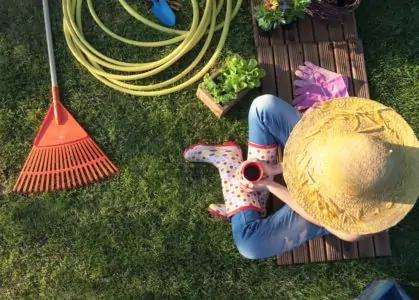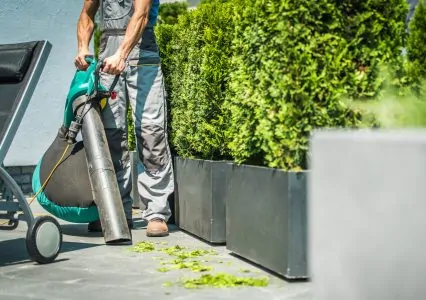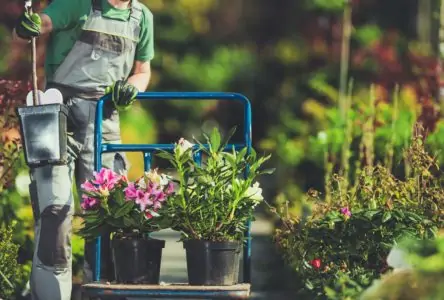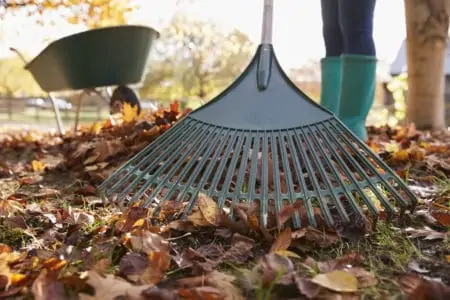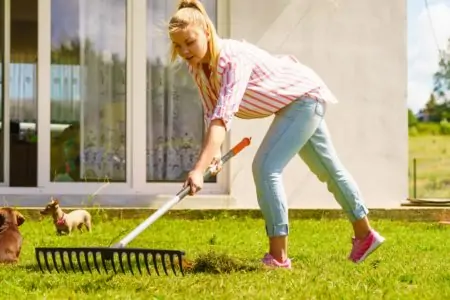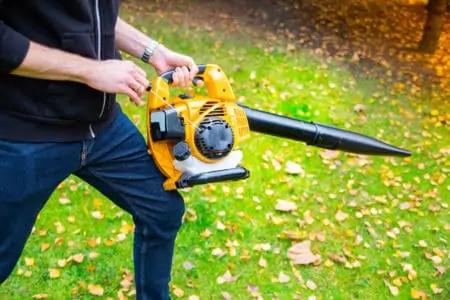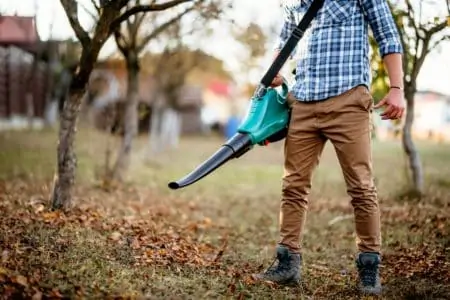A lawn is a place where you can hang out, relax, host parties and have dinner. But if it’s not a neat and tidy space, it can often feel off-putting.
We’ve just moved into a new house and there’s a lot of yard work to be done. But with these lawn care tips put into practice, we’ll have lawns as beautiful as our neighbors’!
Keep reading for 10 helpful lawn care tips, plus answers to a bunch of frequently asked questions. Within a few weeks, you could have a completely different backyard area!
Key Takeaways
- Fertilize your lawn twice a year, in spring and fall, for a healthy, lush-looking yard.
- Remove weeds and moss, and regularly mow your grass to maintain its appearance and health.
- Water your lawn adequately, being careful not to overwater, and aerate the soil for better drainage.
- Top dress and level your lawn for an even surface, and overseed if necessary to maintain thickness.
Lawn Care Tips
While there are a million things you can do to keep your lawn in top condition, our research has brought us to these very important tips.
1. Feed Your Lawn
Feeding your lawn regularly is essential for a healthy, lush-looking yard. It’s important to only fertilize your lawn during the growing season, which equates to roughly twice a year: once in spring, once in fall.
Our top tip is to fertilize your lawn when there is a forecast of rain. The water will wash the fertilizer down into the ground to the roots. If it isn’t going to rain any time soon, water generously with a hose.
Within a week, you should see results and evidence of a greener, fresher, healthier-looking lawn!
2. Get Rid of Weeds
There are hundreds of different types of weeds, and chances are, your lawn has been subjected to at least one kind. It’s important to get rid of the weeds for both the health and aesthetics of your lawn.
The best option you have is to pull the weeds and roots up from the ground by hand or using a tool. You may want to invest in a non-toxic herbicide if the weed-affected area is extensive.
Top Tip
Avoid a chemical lawn weed killer where you can. Not only is it expensive, but it can affect the health of your grass, too.
3. Mow, Mow, Mow Your Grass
It’s not everybody’s favorite outdoor task, but it’s an important one. It’s a good idea to cut the grass weekly in the summer and every two weeks during the rest of the year (obviously not when there is snow on the ground). Regular mowing helps the grassroots spread, which results in more evenly spread grass with fewer bald spots.
Mowing can also help reduce the exponential growth of weeds!
Mowing Tip
As autumn turns to winter, increase the height of the grass blades. If the grass is too short throughout the cold months, frost damage may occur.
4. Deal With Moss
Moss may look quite pretty in forests and other natural environments, but in lawns, it’s a problem. It occurs when a lawn has poor drainage. If you have a moss issue, spring is the best time to fix it.
If you don’t deal with the moss, it will quickly grow, which will inhibit healthy grass growth.
To deal with moss, you have to find the root of the issue, whether that’s shade, excess thatch, clay in the soil, or something else. If nothing works to remove it, you could try using a moss killer.
5. Water Your Lawn
Another basic requirement that’s essential to good lawn health is plenty of watering. Especially for new lawns, you should be watering very often. After this, a healthy lawn should be able to survive with less water unless there are drought conditions.
You should be careful not to overwater your lawn though. More watering equals more growth which will require even more watering to sustain the new growth. Vicious circle, huh?
Signs that your lawn needs watering will include a change in color, a change in growth, and the grass will begin to flatten.
6. Remove Thatch
Like moss and weeds, this is another substance you don’t want on your lawn. Thatch is an organic substance that sits between leaves and soil — it’s dead leaves, root stems, and grass. When it sits on the ground, it actually creates a barrier, preventing moisture and other important nutrients from benefiting the soil.
Remove thatch through stratification, which consists of raking and removing it from the lawn. You can get handy tools to help you with this, such as a lawn dethatcher.
7. Aerate the Soil
This is an important tip that will help improve drainage and stimulate growth. It works by letting more air and moisture get down to the roots. You’ll be thankful you did this, as the results are amazing. It can prevent dry patches in summer and excess mud in winter and spring when it’s wetter.
You will need a garden fork to aerate the soil, or you can use lawn aerator shoes and simply walk all over your lawn! Simple, but fun!
Good To Know
This is a handy tip if you live somewhere affected by drought or waterlogging. It’s good for managing lawns and letting in just the right amount of moisture and nutrients.
8. Top Dress and Level
Topdressing and leveling are essential for uneven lawns. It can improve the quality of the soil and help with drainage and drought resistance.
You can top-dress your lawn by buying a top-dressing material which is often referred to as lawn condition or turf dressing. You can alternatively mix your own using sieved garden soil, sharp sand, and compost.
Brush the mix into the hollow areas of the lawn at no more than one centimeter thick. Be sure not to bury the grass; otherwise, it will die.
9. Over-Seed
Overseeding your lawn may be necessary on damaged or thin lawns. It can bring life back to tired, worn-out lawns. Simply mix together lots of seeds mixed with fertilizer, and apply after you’ve scarified or aerated the lawn. Make sure to mow and water the lawn, too. Then spread the seeds out evenly.
It’s important to keep the grass wet to help advance growth. A top dressing is also encouraged.
You may want to do this when you move to a new place or after your lawn has been damaged. But you can do this annually, too, if your lawn looks a bit worn out.
10. Edge Care
Our final tip is all about those lawn edges. This can create a neat, clipped look to your lawn that ties it all together. Just use a spade or half-moon edger to shape up the edges and tidy everything up.
Edging shears are also very useful for creating a neat edge around your lawn, especially where the mower can’t reach. Cut away uneven or worn edges using a rocking sawing motion as you press down.
Frequently Asked Questions About Lawn Care
Lovely Lawns
These 10 tips and helpful answers to your burning questions should provide some helpful advice for creating a beautiful lawn. When you do these things regularly, you’ll be left with luscious, thick, green grass.
The bottom line is: feed your grass, weed regularly, and mow often. Don’t forget to remove moss and thatch, water the grass on schedule, and aerate the soil for good drainage.
Last but not least, top dress the soil, over-seed if necessary, and take care of the edges for a completed look.
